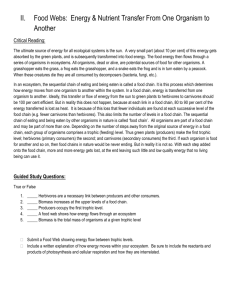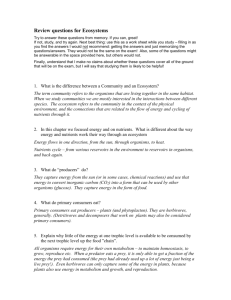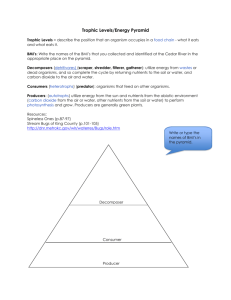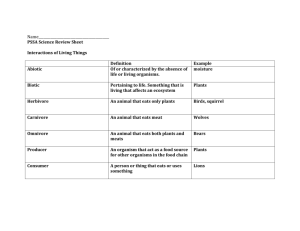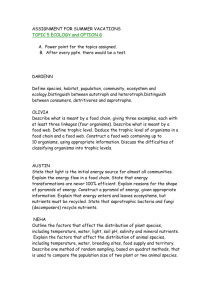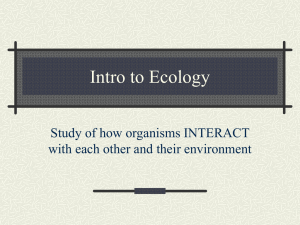Ecosystems and Energy Flow
advertisement
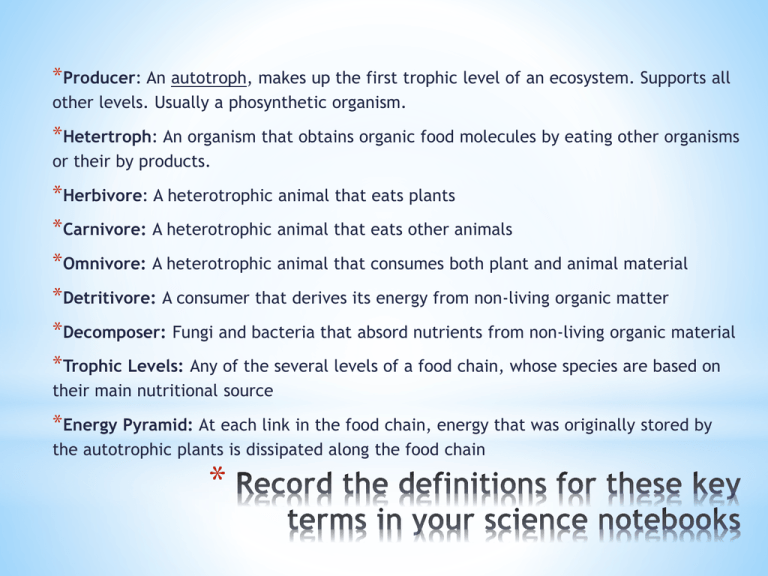
*Producer: An autotroph, makes up the first trophic level of an ecosystem. Supports all other levels. Usually a phosynthetic organism. *Hetertroph: An organism that obtains organic food molecules by eating other organisms or their by products. *Herbivore: A heterotrophic animal that eats plants *Carnivore: A heterotrophic animal that eats other animals *Omnivore: A heterotrophic animal that consumes both plant and animal material *Detritivore: A consumer that derives its energy from non-living organic matter *Decomposer: Fungi and bacteria that absord nutrients from non-living organic material *Trophic Levels: Any of the several levels of a food chain, whose species are based on their main nutritional source *Energy Pyramid: At each link in the food chain, energy that was originally stored by the autotrophic plants is dissipated along the food chain * * * * * * Determine the flow in which energy of the meal travels (from the sun to the student). * * The flow of energy from one organism to another * * A food web * * * A food web is many interconnecting food chains, representing the fact that most organisms eat more than one thing * Because the arrow shows the transfer of energy. The animal that is being eaten transfers some energy to the animal that eats it * * * Idea that energy flux through the food chain decreases at progressively higher trophic levels * Less energy reaches each successively higher trophic level * Energy is lost at each level because of the work performed by organisms at that level and because of the inefficiency of biological energy transformations * Plants gather only a portion of light energy available from the sun, that energy is not available to herbivores as plant biomass * * Producers * Primary Production provides energy to the ecosystem * Primary production varies among ecosystems * *An autotroph is an organism that manufactures its own food from inorganic substances, like carbon dioxide and ammonia * Most autotrophs use light for energy through photosynthesis *Plants and other autotrophic organisms occupy the bottom trophic level * Organisms that obtain energy from the consumption of organic compounds by other organisms are heterotrophs * Heterotrophs can be herbivors, carnivors, detritivores, omnivores * * Consumers of primary producers, herbivores, are called primary consumers * * All organisms are either consumed or end up as detritus * Secondary consumers are carnivores, consume primary consumers * Omnivores feed on more than one trophic level * * Detritivores are organisms specialized to attack wood, leaf litter, and fibrous unabsorbed plant material * Detritus are the dead remains of plants and indifestible excreta of herbivores * Detritivores are important in the recycling of nutrients w/in ecosystems * * Decomposers remove the last energy from the remains of organisms * Decomposers, fungi and bacteria, decompose the dead members of lower trophic levels, thus returning essential elements, such as nitrogen and phosphorus, to the ecosystem * Primary recyclers of the ecosystem * * Microorganisms help recycle nutrients from dead/decaying matter into living organisms * * Does energy accumulate in an ecosystem? * Does a top predator have all the energy? * Do producers receive their energy through the absorption of nutrients? * Is a species high on the food web a predator to everything below?
